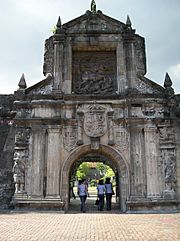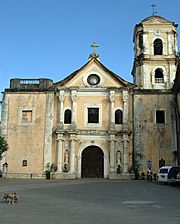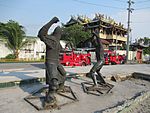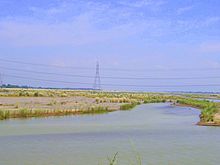Battle of Manila (1574) facts for kids
Quick facts for kids Siege of Manila |
|||||||
|---|---|---|---|---|---|---|---|
| Part of the Spanish colonization of the Philippines | |||||||
|
|||||||
| Belligerents | |||||||
| Chinese pirates Wokou |
|||||||
| Commanders and leaders | |||||||
| Limahong Sioco † |
|||||||
| Strength | |||||||
| 300 Spanish soldiers 300 Ilocano warriors Unknown number of militiamen |
62 war junks 4,000 fighters and seamen |
||||||
| Casualties and losses | |||||||
| 70 Spanish soldiers Unknown number of militiamen |
400 confirmed, much more presumible | ||||||
The Battle of Manila (1574) was a big fight that happened near Manila, especially in what is now Parañaque. It was between Chinese and Japanese pirates, led by a warlord named Limahong, and the Spanish forces who had settled in the Philippines, along with their local allies.
The battle took place on November 29, 1574. Limahong's ships landed in Parañaque and then started attacking the forts in Intramuros, which was the walled city of Manila. At first, the people defending Manila were not ready, and Limahong's forces pushed them back. The pirates even killed the Spanish leader, Martín de Goiti. This slowed down their attack on Manila because Goiti's house blocked their way.
Limahong's forces surrounded Manila. But then, a Spanish group led by Juan de Salcedo arrived and broke the siege. After this defeat, Limahong gave up his plan to take Manila. Instead, he moved to Pangasinan. About a year later, Salcedo's forces defeated Limahong again. This led to the Chinese government sending a representative to the Philippines. Their first goal was to get Limahong back, but they ended up starting diplomatic relations between China and the Spanish Philippines.
Contents
Why Did the Battle Happen?
The first Spanish explorers arrived in the Philippines in 1565. But the city of Manila was officially founded later, in 1571. Once it was built, Manila quickly became a busy trading center. Ships from many places like South Asia, China, and Japan came to trade things like porcelain, silk, and wood.
Manila became famous as a rich city. This fame attracted the attention of pirates and raiders. In 1574, a Chinese warlord named Limahong decided to attack Manila. He had just been chased out of China by their navy. He wanted to move his base to the Philippines, hoping to get more wealth easily.
Limahong captured a Chinese trading ship that had Spanish sailors on it. From these prisoners, he learned that Manila only had about 200 Spanish soldiers. He thought it would be easy to capture the city with a surprise attack.
Limahong's Fleet Arrives
In November, guided by the Spanish prisoners, Limahong reached Luzon. He had a fleet of about 60 large ships called junks. His goal was to kick out the Spanish and take Manila. His group included 2,000 soldiers, 2,000 sailors, and 1,500 colonists. These colonists were entire families, women captured in China and Japan, farmers, carpenters, and doctors. They brought everything needed to start a new settlement. He only left a small part of his group on the island of Batán, where he had hidden from the Chinese navy.
Limahong had help from a Japanese leader named Sioco. Some sources say that many of Limahong's fighters were actually Japanese pirates, known as Wokou. Spanish records also described the invaders' swords as catanes, which sounds like the Japanese word katana. This suggests a mix of Chinese and Japanese fighters. Limahong also had a Portuguese translator with his fleet.
Who Fought in the Battle?
Both sides in the battle had similar weapons and gear. The main difference was that the Spanish soldiers had more experience and better training. They also had strong defensive positions. Plus, help arrived for them at important times.
Both armies used early guns called arquebuses and small cannons. They also fought with swords and daggers. The Asian fighters used long-tipped spears and different kinds of sabers and scimitars. For protection, they wore steel armor, chainmail, and padded cloth jackets called gambesons. The pirates also used many gunpowder hand grenades and fire-starting devices.
The Battle Begins
Spanish lookouts in northern Luzon, led by Juan de Salcedo, spotted Limahong's fleet. Three messengers were sent by sea to warn Manila. But there wasn't enough wind, and the pirate fleet caught up to them. The Spanish messengers had to leave their boats and continue on foot. Because of this, the warning message didn't reach Manila in time.
First Attack on Manila
On November 30, Limahong sent Sioco with 400-600 pirates to attack Manila by surprise at night. But the plan went wrong. Limahong had ordered his Spanish prisoners to be killed when they reached the beach. Without the prisoners to guide them, Sioco's group got caught in strong currents. They lost three boats and accidentally drifted towards Parañaque. Sioco decided to march to Manila on foot, pulling their remaining boats.
The pirates were seen after they attacked some local people in Manila. The locals thought they were Muslim bandits from Borneo. Governor Martín de Goiti was told about this at his house, which was near the old San Agustin Church. But he didn't take it seriously. He only sent ten guards to check, without sounding any alarms or telling the main army.
The pirates quickly killed the guards and surrounded Goiti's house. Goiti's wife, Lucía del Corral, shouted at them from a window. Sioco ordered the house to be set on fire. Finally, Goiti realized how serious the situation was. He and the few men inside rushed out to fight the pirates. Goiti was old and sick, but stories say he jumped from a low window to join the fight. His house was destroyed, and only his wife and one soldier survived.
With Goiti dead, Sioco continued his march towards Manila. But the local people had heard the fighting and warned the Spanish soldiers inside the city. The next in command was Lavezaris, whose house was on the opposite side of the city. Sioco's group was met outside the walls by 20 Spanish soldiers with guns, led by Lorenzo Chacón. They fought the pirates, but the pirates had many more fighters. They surrounded Chacón's group, killing eight before the rest managed to get inside the city. The Chinese pirates chased them, but another group of 80 Spanish soldiers attacked them from the side. Sioco realized he had lost his advantage. He probably feared more Spanish soldiers would arrive. So, he ordered a retreat to Cavite, where they had planned to meet Limahong.
Sioco and his forces got back on Limahong's ships. They planned a second attack after resting for two days. Meanwhile, Lavezaris called all nearby Spanish soldiers to Manila. He also built more defenses, expecting another attack. There was some confusion in Manila, as many still thought the pirates worked for the ruler of Borneo. Lavezaris arrested two local Muslim leaders, suspecting they might be helping the enemy. What really happened is not known, but the two leaders were later found dead in their cells. Soon after, Salcedo arrived in Manila with his own soldiers. Lavezaris made Salcedo the new Maestre de Campo (a high military rank), taking over from Goiti. Salcedo's old command was given to Gaspar Ramírez. By this point, the Spanish forces had 150-200 Spanish soldiers and 200 Ilocano warriors from Bauang, plus some local fighters.
Second Attack on Manila
On the night of December 2, Limahong's fleet was seen arriving in Manila. The first cannon fire happened at dawn. The fleet dropped anchor and sent 1,500 pirates, again led by Sioco. Their smaller boats were sent back to the ships. This was to make sure the pirates would fight hard, knowing they couldn't easily retreat.
After setting many coastal houses on fire with grenades, including the San Agustín Church, Sioco divided his troops into three groups. He hoped to trick the Spanish into leaving the walls so they could be surrounded. But Lavezaris understood his plan. He told his soldiers to stay inside the walls, even when the Chinese fleet moved to get better shooting positions. The Spanish defenses gave them a safer place to shoot back. Finally, Sioco had to act under fire. He ordered his troops to attack the walls from two sides, keeping his third group in the back.

The people defending Manila fought back all the attacks at first. But one of the Spanish leaders, Ensign Sancho Ortiz, was overwhelmed and shot. This left his part of the wall open for the Chinese pirates. The pirates entered the city and fought Salcedo's forces and Francisco de León, Manila's mayor. At the same time, Spanish cannons pushed the Chinese fleet out of the harbor. The main fight then happened in the streets. León was killed by pirates. But soon after, Sioco himself was shot down by a Spanish marksman. Without their main leaders, the Chinese pirates were finally forced out of the city walls.
While the battle was happening, there was trouble behind the Spanish lines. Some local people thought the Spanish would lose. They started looting empty houses. Also, many slaves broke free, trying to escape. They stole boats and tried to flee through the Pasig River. But they were in such a hurry that several boats flipped over. They were also attacked by other local people, who saw a chance to get revenge for past problems. There were also small rebellions in Tondo and Mindoro. Locals there looted Christian churches and took priests as hostages. They planned to offer these hostages to Limahong if he won.
Salcedo chased the pirates to the beach and caused many casualties. But they had to return to the walls when Limahong came back with more ships. He brought 400 more soldiers. Limahong also called one of the three groups Sioco had left behind, gathering about 1,000 men in total. But he decided it was useless to attack again. He called off the assault. His men were sent to loot nearby areas. Limahong also set two stranded ships on fire, hoping to distract Salcedo. But the Spanish captain saw through the trick and attacked the looters. In the end, Limahong called all his soldiers back to his ships and left the shore under fire from Manila.
After the Main Battle
Limahong went to Parañaque and looted it. Meanwhile, Salcedo rebuilt Manila and got ready for a possible third attack. After the battle, a local fighter named Galo was given the Spanish title of don because he was very brave and a good leader.
Lavezaris called for more soldiers from Panay, Camarines, and Cebu to gather a fleet to chase Limahong. Salcedo was sent to deal with the rebellions in Tondo and Mindoro. He personally convinced the local leader Lakandula to surrender and free the captured priests.
The Chase to Pangasinan
The rest of Limahong's fleet was later found on an island in the Agno River in Pangasinan. Francisco de Saavedra had traveled there to warn the Ilocano people about the pirates. Limahong had set up his new home there. He spread stories that he had defeated the Spanish and promised a rich government with no taxes. He hoped to start a rebellion against the Spanish. Saavedra was betrayed by some local people who sold him to Limahong. But he figured it out in time and managed to return to Manila with the news.
Three months later, in March 1575, Lavezaris launched the planned expedition to punish Limahong. He gathered 60 ships with 250 soldiers, 400 sailors, and 1,700 local warriors. This included some Ilocanos who were unhappy with Limahong.
Salcedo learned that Limahong had 2,000 fighters. So, he blocked the river with ships chained together and built forts along the shores. After the first fights, he sent his captains to disable the Chinese ships. They captured some and burned the rest. This left the Chinese pirates with no way to escape. Salcedo's group found a way into Limahong's settlement. They fought Limahong's forces at the outer wall. They were stopped from going further because they got distracted by looting the riches and women they found. Still, they surrounded the settlement tightly.
The siege lasted for four months. The Spanish hoped to make Limahong surrender by starving him out. A Chinese commander named Pesung Aumon arrived unexpectedly to help with talks. He offered Limahong a choice: either become a privateer (a legal pirate) for the Chinese emperor or be destroyed by the Chinese fleet. But Limahong refused. He had a plan to escape. After sacrificing his wounded men, the warlord cleverly broke out of the siege. He moved improvised boats through a secret channel he had dug. Then, he disappeared into the sea. The last time he was seen was at Cape Bojeador in Luzon. Limahong was caught in a storm there before finally escaping.
What Happened Next?
The end of this conflict led to the first political connections between Spain and China. Aumon asked Lavezaris if he could pay for the Chinese captives, as some were noblewomen who had been kidnapped. But the Spanish governor gave them to him for free. He only asked to send a Spanish group to visit the Chinese emperor. This group was led by churchmen Martín de Rada and Jerónimo Martín, and helped by a Chinese merchant named Sinsay, who was a friend of the Spanish. They were ordered to try and start trade relations. However, even though several other groups were sent, the diplomatic relationship cooled down because of problems with the new governor, Francisco de Sande. As for Limahong, he was later defeated in Palau by the Chinese navy. He escaped in a single ship and offered his services in Siam and India before disappearing from history.
See also
 In Spanish: Batalla de Manila (1574) para niños
In Spanish: Batalla de Manila (1574) para niños




